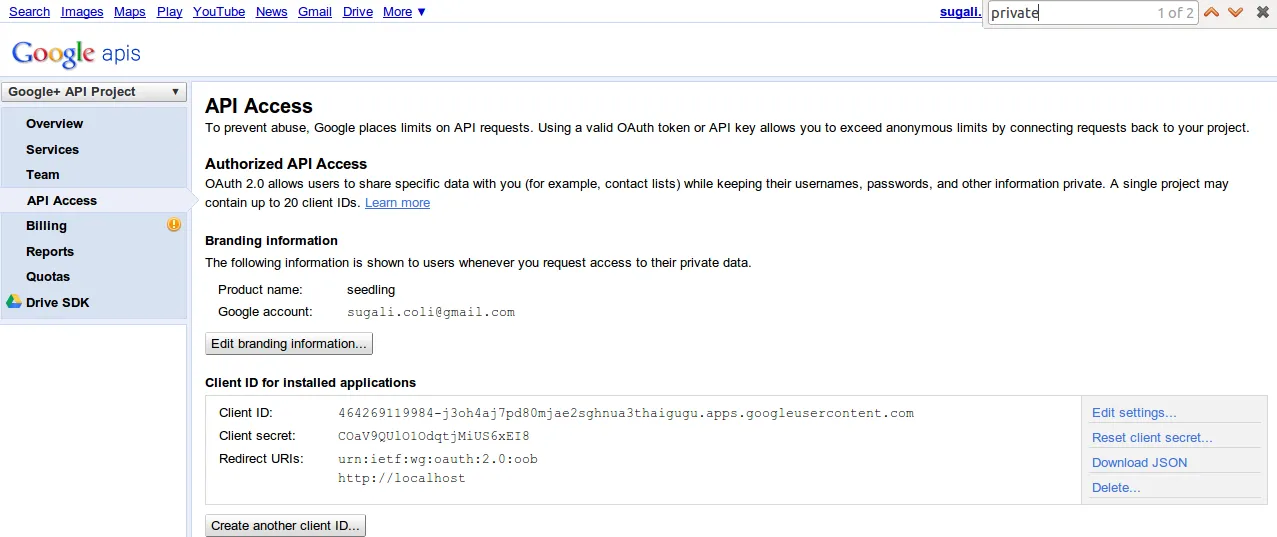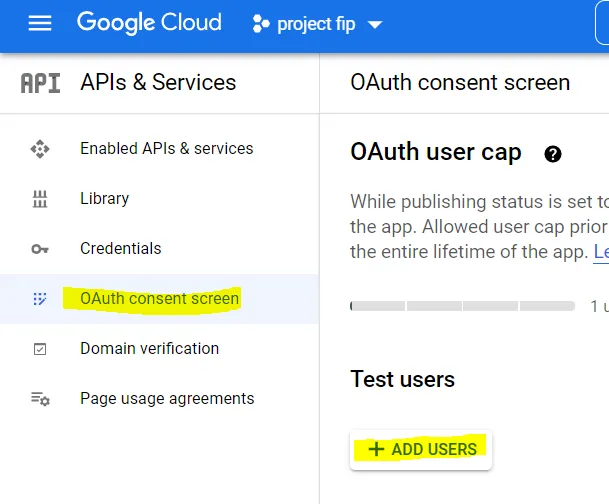我正在尝试在使用PyDrive库 (https://pypi.python.org/pypi/PyDrive) 时自动化 GoogleAuth 过程。
我已经设置好了PyDrive和Google API,以使我的secret_client.json可以工作,但每次运行脚本时都需要进行Web身份验证以访问gdrive:
from pydrive.auth import GoogleAuth
from pydrive.drive import GoogleDrive
gauth = GoogleAuth()
gauth.LocalWebserverAuth()
drive = GoogleDrive(gauth)
textfile = drive.CreateFile()
textfile.SetContentFile('eng.txt')
textfile.Upload()
print textfile
drive.CreateFile({'id':textfile['id']}).GetContentFile('eng-dl.txt')
eng.txt只是一个文本文件。此外,当我尝试在另一个帐户中登录时使用上述脚本时,它不会将eng.txt上传到生成了secret_client.json的gdrive,而是上传到授权身份验证时登录的账户。
从以前的帖子中,我尝试了以下方法来自动化验证过程,但它给出了错误信息:
import base64, httplib2
from pydrive.auth import GoogleAuth
from pydrive.drive import GoogleDrive
from apiclient.discovery import build
from oauth2client.client import SignedJwtAssertionCredentials
from pydrive.auth import GoogleAuth
from pydrive.drive import GoogleDrive
#gauth = GoogleAuth()
#gauth.LocalWebserverAuth()
# from google API console - convert private key to base64 or load from file
id = "464269119984-j3oh4aj7pd80mjae2sghnua3thaigugu.apps.googleusercontent.com"
key = base64.b64decode('COaV9QUlO1OdqtjMiUS6xEI8')
credentials = SignedJwtAssertionCredentials(id, key, scope='https://www.googleapis.com/auth/drive')
credentials.authorize(httplib2.Http())
gauth = GoogleAuth()
gauth.credentials = credentials
drive = GoogleDrive(gauth)
drive = GoogleDrive(gauth)
textfile = drive.CreateFile()
textfile.SetContentFile('eng.txt')
textfile.Upload()
print textfile
drive.CreateFile({'id':textfile['id']}).GetContentFile('eng-dl.txt')
Traceback (most recent call last):
File "/home/alvas/git/SeedLing/cloudwiki.py", line 29, in <module>
textfile.Upload()
File "/usr/local/lib/python2.7/dist-packages/pydrive/files.py", line 216, in Upload
self._FilesInsert(param=param)
File "/usr/local/lib/python2.7/dist-packages/pydrive/auth.py", line 53, in _decorated
self.auth.Authorize()
File "/usr/local/lib/python2.7/dist-packages/pydrive/auth.py", line 422, in Authorize
self.service = build('drive', 'v2', http=self.http)
File "/usr/local/lib/python2.7/dist-packages/oauth2client/util.py", line 132, in positional_wrapper
return wrapped(*args, **kwargs)
File "/usr/local/lib/python2.7/dist-packages/apiclient/discovery.py", line 192, in build
resp, content = http.request(requested_url)
File "/usr/local/lib/python2.7/dist-packages/oauth2client/util.py", line 132, in positional_wrapper
return wrapped(*args, **kwargs)
File "/usr/local/lib/python2.7/dist-packages/oauth2client/client.py", line 475, in new_request
self._refresh(request_orig)
File "/usr/local/lib/python2.7/dist-packages/oauth2client/client.py", line 653, in _refresh
self._do_refresh_request(http_request)
File "/usr/local/lib/python2.7/dist-packages/oauth2client/client.py", line 677, in _do_refresh_request
body = self._generate_refresh_request_body()
File "/usr/local/lib/python2.7/dist-packages/oauth2client/client.py", line 861, in _generate_refresh_request_body
assertion = self._generate_assertion()
File "/usr/local/lib/python2.7/dist-packages/oauth2client/client.py", line 977, in _generate_assertion
private_key, self.private_key_password), payload)
File "/usr/local/lib/python2.7/dist-packages/oauth2client/crypt.py", line 131, in from_string
pkey = crypto.load_pkcs12(key, password).get_privatekey()
OpenSSL.crypto.Error: [('asn1 encoding routines', 'ASN1_get_object', 'header too long')]
我的gdrive api身份验证如下:

我该如何使用PyDrive,以便每次使用它时都不需要进行身份验证?
如何允许自动身份验证,以使使用PyDrive脚本的python脚本仅上传到生成secret_client.json的帐户,而不是当前在互联网浏览器上登录的帐户?

client_secrets.json来对应用进行身份验证。mycreds.txt将存储可以用于对用户进行身份验证的令牌。因此,第一次运行此代码时,您需要通过Web浏览器输入验证代码。第二次运行时,它应该使用保存在mycreds.txt中的凭据。 - danosettings.yaml文件,其中包含get_refresh_token: True,才能使其正常运作。 - agenis